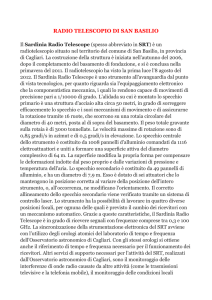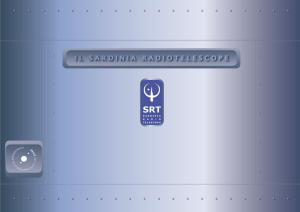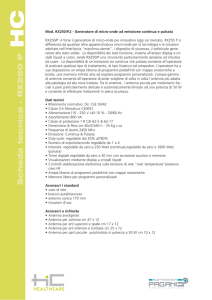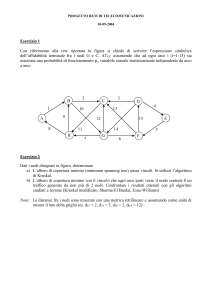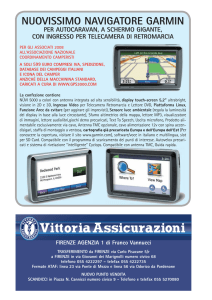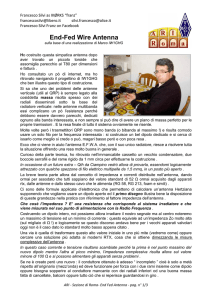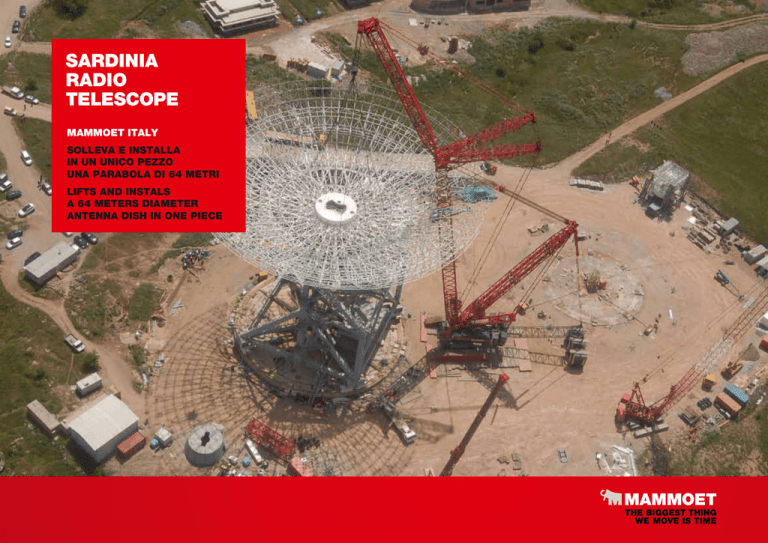
SARDINIA
RADIO
TELESCOPE
MAMMOET ITALY
SOLLEVA E INSTALLA
IN UN UNICO PEZZO
UNA PARABOLA DI 64 METRI
LIFTS AND INSTALS
A 64 METERS DIAMETER
ANTENNA DISH IN ONE PIECE
PRONTI - READY
A
SOLLEVAMENTO - LIFTING
Z
Alcuni progetti si sviluppano in modo strano. Sembrano partire alla grande, poi svaniscono
e alla fine ritornano improvvisamente a giungono a termine sul velluto, pur dovendo
superare numerosi ostacoli. Il Sardinia Radio Telescope è un caso classico di questo tipo.
Nei tardi anni ’90 del secolo scorso, la Facoltà di Astrofisica dell’Università di Cagliari iniziò a
pianificare la costruzione di un nuovo radiotelescopio gigante, destinato ad essere collegato nella
rete mondiale di strumenti simili che lavorano sulle ricerche di Interferometria a Larga Base, ma in
grado anche di operare come strumento isolato. Il progetto prevedeva un’antenna singola a parabola
del diametro di 64 metri, assemblata in loco come struttura tubolare, il che ne avrebbe fatto il più
grande radiotelescopio ad antenna singola d’Europa. Nel 2001 Mammoet Italy ricevette la richiesta
di studiare il progetto per verificare se fosse possibile sollevare e installare la parabola già completamente assemblata. I vantaggi che ne sarebbero derivati dal punto di vista delle tempistiche e i costi
Some projects have a strange way to come along. They seems to start well, then fade away
and lastly they come back all of suddenly and go to fruition smoothly if challenging. The
Sardinia Radio Telescope is just such a case.
In late ‘90s the Astrophisics Faculty of the Cagliari’s University, in the island of Sardinia, started to
plan for a new giant radiotelescope, to be linked to a worldwide network of similar instruments that
worked together on Large Base Interferometry research, but also capable to act as a single
instrument too. The project involved a single dish antenna 66 meters in diameter, built as a tubular
structure onsite, that woud have had been the largest single-dish radiotelescope in Europe. In 2001
Mammoet Italy was asked to study the project to see if it was possible to lift and install the dish in
sono evidenti. Lo studio andò bene: era in effetti possibile sollevare l’antenna in un solo pezzo dopo
averla assemblata a terra.
A questo punto il progetto sembro' distanziarsi da Mammoet. Prima una serie di difficoltà burocratiche
e di finanziamenti ritardarono l’inizio della costruzione del telescopio, poi un appaltatore dopo
l’altro rinunciò all’incarico di trasportare e sollevare gli elementi dell’antenna. Il sito prescelto per il
radiotelescopio, che a questo punto si chiamava SRT (Sardinia Radio Telescope), è un altopiano a
700 metri sul livello del mare nell’interno della Sardegna a 35 chilometri da Cagliari. In quella zona
le strade sono di montagna, non progettate per far passare il traffico pesante necessario a portare
gli elementi dell’antenna e della gru, richiesta per sollevarla. Inoltre, per sollevare un carico così
grande, e pesante 500 tonnellate, sarebbe stata necessaria una gru speciale molto grande, come
la Liebehrr LR11350.
one piece. The advantages from timing and cost point of view are evident. The study went well: it
was indeed feasible to lift the dish in one piece after having it assembled on the ground.
Then the project seemed to distance itself from Mammoet. First a series of burocratic and funding
difficulties delayed the actual construction of the telescope, then one bidder after another fell out of
the commission to transport and lift the antenna elements. The site chosen for the radiotelescope,
that was now called SRT (Sardinia Radio Telescope) is located on a highland plateau at 700 meters
high on sea level, 35 Km inland from Cagliari, on the southern coast of Sardinia. Roads there are
mountain roads, not conceived to carry a lot of heavy traffic like those needed to carry the elements
of the antenna and of the crane to lift it. Besides, to lift such a large piece of equipment, weighing
500 metric tons, a large special crane was necessary, like the LR11350.
POSIZIONAMENTO - POSITIONING
ASSEMBLAGGIO - ASSEMBLING
Z
Poi tutto ad un tratto all’inizio del 2010, tutti i pezzi del puzzle andarono a loro posto. Quasi nello
stesso momento, gli elementi della parabola furono completati presso il sito, la società di costruzioni
meccaniche che lavorava al SRT, la I.CO.M., decise di impegnarsi nel completamento del progetto
e, più importante di tutto, Mammoet Italy si trovò ad avere una LR11350 con una capacità di 1350
tonnellate a 60 chilometri dal sito del SRT, reduce da due commesse nella raffineria SARAS di
Sarroch vicino a Cagliari. Era ora o mai più. Mammoet Italy si aggiudicò la commessa e spedì la gru
disassemblata al sito SRT, nel comune di San Basilio, utilizzando più di 60 trasporti eccezionali, una
sfida di per sé viste le dimensioni e lo stato delle strade.
Dopo avere assemblato e posizionato la gru, fu il turno del tempo atmosferico a porre problemi. In
quelle zone montane nell’interno della Sardegna il tempo può essere tempestoso e ventoso, e una
struttura larga 64 mt tenderebbe a comportarsi in modo terribilmente imprevedibile se investita da
raffiche di vento improvvise. Nonostante il piano di sollevamento fosse stato approntato prevedendo
tutti questi fattori di rischio, fortuna volle che la mattina prevista per il sollevamento il tempo fu
fantastico e il vento completamente assente, facilitando al massimo l’operatività e rendendo ancora
più spettacolare l’operazione. L’antenna venne sollevata e installata in appena un’ora di lavoro, sotto
gli occhi di più di 500 persone, quasi la metà della popolazione della cittadina di San Basilio. Il
sindaco aveva addirittura noleggiato due pulmini per portare i ragazzini delle scuole elementari a
vedere lo spettacolo. La parabola si sollevò senza problemi, con il cavo fissato ad un gancio posto
nel centro di gravità. La gru lavorava con un braccio lungo 80 metri e con un raggio di 35 metri, a
causa del grande diametro del carico.
Dopo l’installazione dell’antenna, l’SRT ha richiesto altri due anni per il completamento e ha visto la
“prima luce” nell’agosto del 2012. Oggi il telescopio viene gestito dall’Istituto Italiano di Astrofisica e
sta scandagliando con successo i cieli in un’ampia gamma di frequenze radio, per studiare oggetti
molto differenti, dal nostro Sole a radiogalassie estremamente distanti.
Then suddenly in early 2010 all the pieces went in place. Almost simultaneously, the dish was
completed, the mechanical construction company working on the SRT, I.CO.M., decided to commit
itself to the complition of the project, and, more over, Mammoet Italy had an LR11350 with 1350
metric tons of lifting capacity within 60 Km of the SRT site, that was just finishing working on two
projects in SARAS refinery in Sarroch, near Cagliari. It was now or never. Mammoet Italy got the
contract and shipped the disassembled crane to the SRT site, in the municipality of San Basilio, with
more the 60 heavy truckloads, a challenge itself, considering the size and shape of the roads.
After reassembling and positioning the crane, it was the weather that turned to be a challenge. In
those mountains in the interior of Sardinia the weather can be stormy and windy, and a 64 meter
trellis dish tend to react unpredictably to sudden wind gusts. Fortunately that morning the weather
was sunny and the air was still. The dish was lifted and installed in one hour, watched by more than
500 people, almost half the population of the small village of San Basilio. The mayor of the village
hired two coaches to carry the children of the local primary school to come see the show. The dish
went up smoothly, tied to a center of gravity attachment, with the crane working with 80 meters of
main boom at 35 meters radius to allow for the large diameter of the dish.
The SRT needed two more years to be finished and saw “first light” in August 2012. Operated by
the Italian Istitute of Astrophysics, it is now successfully scanning the skies in a range of radio
frequencies, studying topics as different as our Sun and extremely distant radiogalaxies.
Mammoet Italy S.r.l. • Bastioni di Porta Volta, 7 • 20121 Milan (MI) • Italy

